| |
|
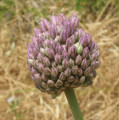 | |
| MaltaWildPlants.com by Stephen Mifsud |

|
| |
|
|
 |  |  |  |
| External Links: |
|
Ophrys bombyliflora (Bumble-Bee Orchid) |

Ophrys bombyliflora (ORCHIDACEAE.)
Images for this profile are taken from the Maltese Islands after year 2000. |
|
| Nomenclature |
Species name : | Ophrys bombyliflora Link | Authority : | Johann Heinrich Friedrich Link, Germany, (1767 - 1851) | Synonyms :
(basionym or principal syn.) |
|
Plant Family : | | English name(s) : | Bumble-Bee Orchid | Maltese name(s) : | Brimba griża | Status for Malta : | Indigenous. Present on the Maltese islands before man | Name Derivation : |
Ophrys: Eyebrow, referring to the brown, furry edges found in the flowering lips of several. (Latin origin ); 2 = "Eyebrow", referring to the furry edges of the lips of several species. (Greek);.
bombyliflora: Shape of a bumblebee, with reference of the semi-spherical, winged and hairy flower of this species. (Greek origin ); 2 = silky texture - referring to the labellum of the flower (Latin).
| Remarks : | |
|
| Morphology and structure |
PLANT STRUCTURE: |
Character | Growth Form | Branching | Surface |
Description | | | |
General
Picture |  | 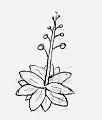 | 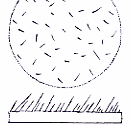 |
|
LEAVES: |
Character | Arrangement | Attachment | Venation |
Description | | | |
General
Picture | 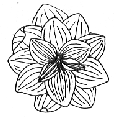 | 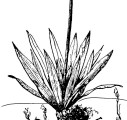 |  |
| |
Character | Leaf Shape | Leaf Margin | Remarks |
Description | | | |
General
Picture |  |  |  |
|
FLOWERS: |
Character | Colour | Basic Flower Type | No. of Petals | No. of Sepals |
Description | Brown and pale violet | | 3 2 small and inconspicuous and 1 complex and colourful (labellum). | 3 Identical, green and oval-lanceolate in shape. |
General
Picture | |  |  |  |
| |
Character | Inflorescence | Description | Ovary | Stamens |
Description | | Flower consists of 3 identical, leaf-like, outer perianth segments (= sepals) and 3 inner perianth segments (= petals) of which 2 are small and green and the other, called labellum, is a modified lip-shaped petal. The labellum is very conspicuous and colourful - dark brown with violet patches. It has 3 lobes, with the lateral ones being hairy and pointing backwards, and the large lobe is rounded, swollen with a whitish hairy pointed base. It often has a central violet patch in the shape of an X or H. | | |
General
Picture |  |  |  | 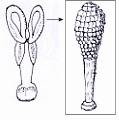 |
| |
Character | Scent | Average Flower Size | Pollen Colour | Other Notes |
Description | None or very faint Emits an odour resembling an insect pheromone (sex hormone), for attracting the specific pollinator. | 8mm x 10mm (Length x Breadth). | Yellow | - |
|
SEEDS: |
Character | No. Per Fruit | Shape | Size | Colour |
Description | > 2,000 Despite the large amounts, propagation by seeds is not much viable for Orchids . | Powder form (very small to have a distinct shape ). | Extremely small (powder form). | Ash Gray |
General
Picture |  |  |  |  |
|
FRUIT AND OTHER BOTANICAL DATA: |
Character | Fruit Type | Colour of Fruit | Subterranean Parts | Other Notes |
Description | | Green (turns light brown when ripe.). | | Germination and Growth The germination and growth of the plant is successful only with the presence of specific microrhizzial funghi in the soil. |
General
Picture |  |  | 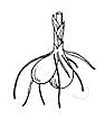 |  |
|
|
| Plant description and characters | |
Life Cycle: | Perennial. |
Growth Form: | GEOPHYTE (bearing underground bulbs, rhizomes, stolons, etc.) |
Habitat: | Garigue, open maquis, steppe with grasses, usually in exposed rocky areas |
Frequency: | Common |
Localities in Malta: | Frequent but decreasing. Located at Ta' Darrenzi (Mgarr), Rdum tal-Madonna (Mellieha), Wied iz-Zurrieq, Dwejra (garigue overlooking the chapel), Pembroke and Bahrija (garigue behind the church). |
Plant Height: | 8-22cm. |
| Mar |
Protection in Malta: | Not legally protected till the last update of this website (2/Mar/2022) |
Red List 1989: | Not listed in the Red Data Book of the Maltese Islands |
Poison: | |
This small and quite inconspicuous plant is found with difficulty in isolated patches in garigue and rocky places lying amongst other vegetation in the site. The plant forms a basal rosette of leaves and at a later stage it shoots a flowering stem that forms spikes of 1 to 5 flowers. The stem is glabrous and sometimes there are leaves at the lower part which clasp the stem.
The basal, pale green leaves have a broad lanceolate shape with typical parallel veins and entire margins.
The flowers are attached to the flowering stem at its elongated green ovary. There is also a hood-shaped bract which is shorter than the ovary and covers it partially. The flowers have no petioles and so the inflorescences is described to be a spike. The flower have 3 similar outer segments (=sepals) which are pale green, rounded and roughly perpendicular to each other. There flower also possess 3 inner segments (=petals) of which 2 are small (2-3mm long), hairy and green with a purple-brown base and the other segment, called labellum, is much larger (8-10mm long), have compound shape and its colour is dark brown with pale violet patches.
The labellum has 3 lobes. The lateral lobes are smaller, curved and pointing downwards and covered with white hairs, while the central main lobe is roundish, curved up (as if swollen) and have a velvety texture. It has no hairs except at the rounded and pointed tip which is covered with cream coloured hairs. The body of the labellum has a dark reddish-brown colour with patches of pale violet colour forming the shape of an 'H' or 'X' in many flowers . The function of the labellum is to mimic the body of a resting female bee so as the male bee will try to mate on/with the flower and doing so it carries out the pollination process of the flower.
The mouth of the flower have a black border and is glabrous. At the upper part of the mouth there is the 2 separate, globular, black pollinia above which there is an interesting reddish or orange striped small appendage. The flower do not possess a spur and is not particularly scented, though some state that it has a scent of female bumblebee pheromones to attract male bumblebees.
The flowers can develop green fruit which are dehiscent and elongated capsules that produce numerous tiny or rather microscopic seeds. The plant reproduce asexually by forming underground, ovoid tubers, or sexually by seeds, of which the former method is much more successful. Reproduction by seeds is very difficult.
|
|
| Information, uses and other details |
Nativity
This species is found throughout the Mediterranean and Canary islands. [WWW-90, 332] For example it is found in Portugal, Spain, France, Italy, and Malta. No information about if this species is found in North Africa too. [SM]
Medicinal Uses
| Demulcent |
A medication (in the form of an oil or salve etc.) that soothes inflamed or injured skin. [WWW-32] |
| Nutritive |
Of or pertaining to nutrition; having the quality of nourishing; nutritious; nutrimental; alimentary [WWW-32] |
Salep is very nutritive and demulcent [4]. It has been used as a diet of special value for children and convalescents, being boiled with water, flavoured and prepared in the same way as arrowroot [4]. Rich in mucilage, it forms a soothing and demulcent jelly that is used in the treatment of irritations of the gastro-intestinal canal [4]. One part of salep to fifty parts of water is sufficient to make a jelly [4]. The tuber, from which salep is prepared, should be harvested as the plant dies down after flowering and setting seed [4].
Edible Uses
The root can be eaten when cooked. It is a source of 'salep', a fine white to yellowish-white powder that is obtained by drying the tuber and grinding it into a powder [200]. Salep is said to be very nutritious and is made into a drink or added to other cereals and used in bread etc [183]. One ounce of salep is said to be enough to sustain a person for a day [100, 115]. The salep can also be made into a drink [100].
Cultivation Details
Plants can be grown in a lawn, but the lawn must not be cut until the plants have set seed [200].
Orchids are, in general, shallow-rooting plants of well-drained low-fertility soils. Their symbiotic relationship with a fungus in the soil allows them to obtain sufficient nutrients and be able to compete successfully with other plants. They are very sensitive to the addition of fertilizers or fungicides since these can harm the symbiotic fungus and thus kill the orchid [230]. This symbiotic relationship makes them very difficult to cultivate, though they will sometimes appear uninvited in a garden and will then thrive. Transplanting can damage the relationship and plants might also thrive for a few years and then disappear, suggesting that they might be short-lived perennials [230].
This species is not hardy in the colder areas, it tolerates temperatures down to between -5° C and -10° C [200] which is never reached in Malta [SM].
The flowers resemble a female insect (a bumblebee) and also emit a scent similar to female pheromones, they are pollinated by a male insect of that species attempting to copulate with the flower[200].
Tubers should be planted out whilst they are dormant, this is probably best done in the autumn[200]. They should be planted at least 5cm below soil level[200].
Propagation Details
Seed - surface sow, preferably as soon as it is ripe, in the greenhouse and do not allow the compost to dry out. The seed of this species is extremely simple, it has a minute embryo surrounded by a single layer of protective cells. It contains very little food reserves and depends upon a symbiotic relationship with a species of soil-dwelling fungus. The fungal hyphae invade the seed and enter the cells of the embryo. The orchid soon begins to digest the fungal tissue and this acts as a food supply for the plant until it is able to obtain nutrients from decaying material in the soil [200]. It is best to use some of the soil that is growing around established plants in order to introduce the fungus, or to sow the seed around a plant of the same species and allow the seedlings to grow on until they are large enough to move.
This species only rarely forms new offsets and so division is seldom feasible, the following methods can be tried, however [230].
Division of the tubers as the flowers fade [230]. This species produces a new tuber towards the end of its growing season. If this is removed from the plant as its flowers are fading, the shock to the plant can stimulate new tubers to be formed. The tuber should be treated as being dormant, whilst the remaining plant should be encouraged to continue in growth in order to give it time to produce new tubers [230].
Division can also be carried out when the plant has a fully developed rosette of leaves but before it comes into flower [230]. The entire new growth is removed from the old tuber from which it has arisen and is potted up, the cut being made towards the bottom of the stem but leaving one or two roots still attached to the old tuber. This can often be done without digging up the plant. The old tuber should develop one or two new growths, whilst the new rosette should continue in growth and flower normally [230].
Sexual reproduction of the flower
A Eurasian genus Ophrys has flowers that look and smell so much like female bees that males flying nearby are irresistibly drawn in, such as with the Bumblebee Orchid (Ophrys bombyliflora). The viscidium, and thus pollinia, stick to the head or the abdomen of the bumblebee. On visiting another orchid of the same species, the bumblebee pollinates the sticky stigma with the pollinia. The filaments of the pollinia have, during transport, taken such position that the waxy pollen are able to stick in the second orchid to the stigma, just below the rostellum. Such is the refinement of the reproduction. If the filaments hadn't taken the new position, the pollinia could not have pollinated the original orchid. [WWW-89]
Personal Observations
Occurrence of the plant in Malta
The plant is becoming rare in Malta. In a Maltese book about the flora of Malta written in 1977 [332] the plant was described to be frequent. The authors wrote that the plant was found in the following sites: Manoel Island, Wied Ghomor, Wied Babu, Gnejna, Wied Gerzuma, Kordin, Wied Incita, Buskett, Ghar il-Kbir, Mellieha, Mistra, Ghajn Tuffieha and the following in Gozo: Xlendi, Dwejra, Mgarr ix-Xini, Ta' Cenc, Pergla.
In spring 2005 the plant has been found in Mgarr, (a garigue known as ta' Darenzi), l-ahrax tal-Mellieha [SM] Rdum tal-Madonna, Rdum id-Delli, Wied iz-Zurrieq, Dwejra lines (garigue overlooking chapel ),Bahrija (garigue behind new church), Pembroke. In the latter three places it is found in considerable numbers [SB] but in the large garigue area of Ta' Darenzi (Mgarr), there was only one patch of about 12 - 15 plants in close vicinity to each other [SM]
The difficult propagation cycle of the plant (which its successful growth depends on a symbiotic Rhizoctonia fungus) and adverse anthropologic activities during the last years may have contributed to make this beautiful plant becoming more rare in our islands. Transplanting is usually unsuccessful as the destination soil would unlikely have the symbiotic fungus. For this reason it is important to pass this education so as to protect this plant from over-picking. [SM]
|
|
| Links & Further literature
(4 papers) |

Google Web |

Google Images |

Google Scholar |

Research Gate |

Wikipedia |

JSTOR |

GBIF |

Med Checklist |

Cat. of Life |

EoL |

IPNI |

World Flora Online |

Plants of the World Online |

Vienna Virt. Herb. |

RBGE Herbarium |

KEW Herbarium |

MNHN |

Arkive |

IUCN |

CABI | |
| Photo Gallery (36 Images) | 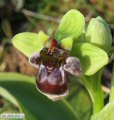 |
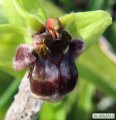 |
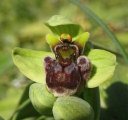 |
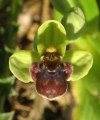 |
IMAGE: OPHBO-01 Photo of the dark reddish-brown flower in situ. |
IMAGE: OPHBO-02 Close up photo of flower from a different angle. The mouth of the stigmatic cavity is glabrous (almost shiny) and lined black. |
IMAGE: OPHBO-03 Close up photo of the velvety flower. The labellum consists of 3 lobes with the 2 smaller and lateral ones are found pointing backwards and very hairy, whereas the central, larger lobe have a globular shape with a white to pale yellow short hairs at the tip. |
IMAGE: OPHBO-04 Photo of flower resembling a female bee. The male bee, thinking the flower is actually his female partner, tries to mate with the flower and doing so, pollen sacs (called pollinia) stick to the head of the bee. When the male flies to another flower mature pollen will be transferred in the stigmatic cavity (female parts of the flower) and so carry out the pollination process. |
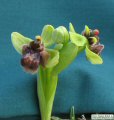 |
 |
 |
| IMAGE: OPHBO-05 Photo of the inflorescences against a green background. The plant forms loose spikes of usually 2 to 5 flowers, in seldom cases even more. |
IMAGE: OPHBO-06 Close up photo of the flower. Note that there are pollen grains in the stigmatic cavity of the flower, that is the flower has been already pollinated by a male bee. |
IMAGE: OPHBO-07 Photo of a flower. One of the pollinia (yellow structure) is partly detached outside its housing. The spherical hyaline structure at the base is known as the viscidium - a sticky substance by which the pollinia adheres firmly with the body of the male bee (the pollinator) and gets carried away. |
IMAGE: OPHBO-08 - |
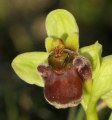 |
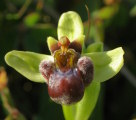 |
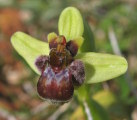 |
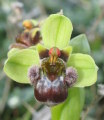 |
IMAGE: OPHBO-09 This specimen has very little blue markings on the labellum. There is a considerable degree of variation in the labellum markings between different specimens. |
IMAGE: OPHBO-10 Photo of another attractive specimen. |
IMAGE: OPHBO-11 Photo of the flower of this plant found in numerous numbers at Pembroke (Malta) on mid March 2006. |
IMAGE: OPHBO-12 Photo of a another beautiful flower with contrasting milky blue speculum on the labellum. |
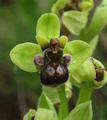 |
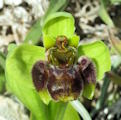 |
 |
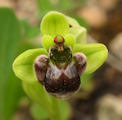 |
IMAGE: OPHBO-13 Photo of specimen with a milky-blue speculum having a slightly darker central patch. |
IMAGE: OPHBO-14 Photo of specimen with a grey-blue small speculum margined by a milky-blue colour. |
IMAGE: OPHBO-15 Photo of an unusual form which was only encountered once. It has a very contrasting and relatively large white speculu, with a milky-blue centre. The hairs on the lateral lobes are longer from the typical form. |
IMAGE: OPHBO-16 Photo of another specimen with a pale blue speculum. Being more attractive, such specimens are more photographed and displayed in this webpage, but it does not mean they are much more common than those with a dull / inconspicuous speculum (see next image). The latter are in fact described as the typical form and are more common. |
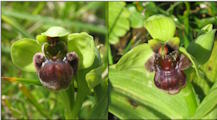 |
| | 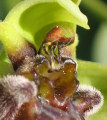 |
IMAGE: OPHBO-17 Photo of 2 typical specimens each with an inconspicuous, rather dull speculum. In this image one can observe the variation present also in the upper petals. The specimen on the right has half the lenght of the upper petals brown which rapidly fades to green apex, while the other specimen have them almost all green. |
IMAGE: OPHBO-18 - |
IMAGE: OPHBO-19 - |
IMAGE: OPHBO-20 Close up photo of the flower mouth showing the detail of the stamenoid column. |
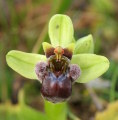 |
 |
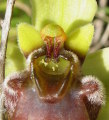 |
 |
IMAGE: OPHBO-21 Photo of another flower (Pembroke, March 2006). |
IMAGE: OPHBO-22 Lateral view photo of the flower, showing well how the lateral lobes are curved downwards (away from the labellum plane). It also shows the spherical body of the labellum. |
IMAGE: OPHBO-23 Close up photo of the mouth and the stamen column of the flower. Note that this flower have the pollinia missing, most probably carried away by a pollinator. Also the stigmatic cavity at the mouth of the flower contains some yellow pollen grains from another flower. |
IMAGE: OPHBO-24 Photo chart of 9 specimens showing the variation that the flowers can exhibit in Malta - mainly in the bluish marking (the speculum) of the labellum. The specimens does not represent the distribution proportion and specimens with unobtrusive speculum (B2-B3) are as or more common than those with a milky-blue one. |
 |
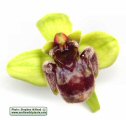 |
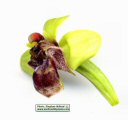 |
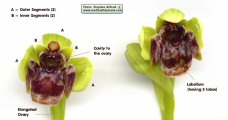 |
IMAGE: OPHBO-25 Scanned image of flowering stem showing the green bract covering part of the elongated ovary The ovary is longer than the bract and is connected directly to the stem (no petiole). |
IMAGE: OPHBO-26 Scanned image of flower. It consists of 3 outer segments (=sepals) and 3 inner segments of which 2 are small pointing up and hairy, while the other one , called labellum, is large, coloured and have a complex shape in the form of a bee. |
IMAGE: OPHBO-27 Scanned image of flower (side view). The lateral lobes of the labellum are very hairy, while the central lobe is made of a velvet like texture (hence the species name bombyliflora). |
IMAGE: OPHBO-28 Scanned and annotated image of two flower. |
 |
 |
 |
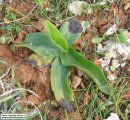 |
IMAGE: OPHBO-29 Scanned and annotated image of a longitudinal dissection of flower. |
IMAGE: OPHBO-30 Scanned image of a longitudinal dissection of ovary showing the immature tiny ovules. |
IMAGE: OPHBO-31 Photo of the yellow pollinia just removed from the flower. Pollen is coherent (stuck together) as small pouches. |
IMAGE: OPHBO-32 Photo of basal rosette of leaves of plant. The tips are blackened due to environmental factors namely cold. |
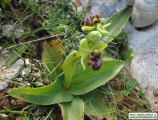 |
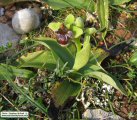 |
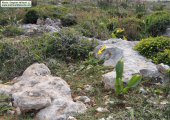 |
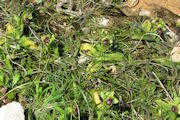 |
IMAGE: OPHBO-33 Photo of leaves in situ. They are pale green in colour, have a broad lanceolate shape with entire margins and parallel venation. |
IMAGE: OPHBO-34 Photo of the low-growing plant (15cm c.) taken at Mgarr (ta' Darenzi area) on March 2005. |
IMAGE: OPHBO-35 Photo of the habitat of Ophrys bombyliflora which prefers damp mossy soil in shallow rock basins in karst rock. Such habitats are low garrigue or steppe. |
IMAGE: OPHBO-36 Scattered population of Ophrys bombyliflora in Malta, which is often found accompanied by low grassy lawns, Romulea spp. Linum spp., and Scilla autumnalis to mention a few examples. |
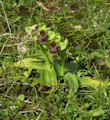 |
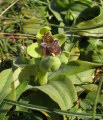 |
 |
| IMAGE: OPHBO-37 Photo of 3 specimens in situ. |
IMAGE: OPHBO-38 Photo of the low-growing plant. This one measured just 8cm. |
IMAGE: OPHBO-39 Photo of male wild bee pollinating a flower of Ophrys bombyliflora believing he is copulating a female bee, owing to the shape and odour of the flower (phermones) that mimics a female wild bee. The species was identifed as Eucera oraniensis thanks to the courtesy of Prof. Hannes Paulus. |
IMAGE: OPHBO-40 |
|
| | |

